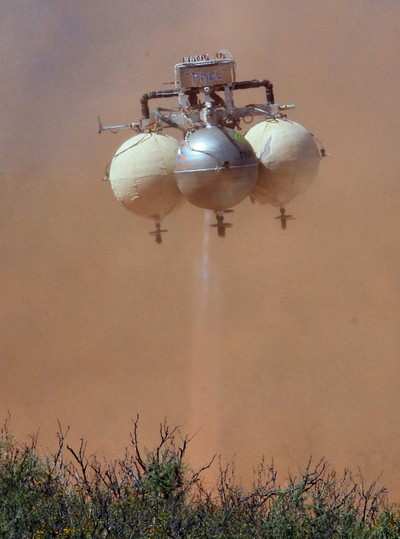John Carmack's Armadillo Crew Impresses Space Community
 The Northrop Grumman
Lunar Challenge only wound up with one competitor this year,
despite a number of parties pursuing the mission. Taking on the
challenge, for the first time, was John Carmack's truly magnificent
Armadillo Aerospace team... fielding two vehicles, one named Texel
and the other, Pixel...
The Northrop Grumman
Lunar Challenge only wound up with one competitor this year,
despite a number of parties pursuing the mission. Taking on the
challenge, for the first time, was John Carmack's truly magnificent
Armadillo Aerospace team... fielding two vehicles, one named Texel
and the other, Pixel...

As the accompanying photos show, there was were a number of
attempts, lots of great flying, and some truly expert work done in
order to pursue this lofty goal... but the final flight on Saturday
(shown in the last four pix), the one that would have earned
Armadillo the first tier prize, was frustrated when minor damage
done in the previous landing caused a series of events that
initiated an inflight abort when the vehicle banked too
aggressively shortly after liftoff, and the vehicle went down,
damaging itself beyond the ability to fly again.

As the official XPrize news and photo team, ANN had very close
access to these missions and came away impressed with the ingenuity
and inventive spirit espoused by Carmack's Rocketeers. While they
did not succeed with this outing, we have little doubt that this
team will be leading the way to successful attempts in the future.
no kidding... these guys were amazing.

XPrize Explains The (Many) Challenges
How amazing were they? Think about it.. the XPrize folks tell
ANN that our return to the Moon requires a new generation of lunar
vehicles. In these competitions, teams must demonstrate the ability
to launch vertically, hover, land precisely, refuel and refly.

The Vertical Lander Challenge (VLC) and Lunar Lander Challenge
(LLC) presented by NASA are designed to accelerate the commercial
development of a vehicle capable of ferrying cargo or humans back
and forth between the surface of the Moon and low moon orbit
(approximately 50 meters).

The primary differences between the Vertical Lander Challenge
and the Lunar Lander Challenge are the minimum time of flight (90
vs. 180 sec.), the surface terrain at the landing sites (flat vs.
rocky) and the degree of difficulty presented for precision
landing.

Such a vehicle would have direct application to NASA's space
exploration goals as well as the personal spaceflight industry.
Additionally, the prize will help industry build new vehicles and
develop the operational capacity to operate quick turnaround
vertical take-off, vertical landing vehicles, which will be of
significant use to many facets of the commercial launch procurement
market.

To win either challenge, a rocket-propelled vehicle with an
assigned payload must take-off vertically, climb to at least 50
meters, fly for a pre-determined minimum amount of time and land
vertically on a target that is approximately 100 meters from the
takeoff point. The vehicle must then fly back to the original pad
under the same guidelines and land on the original launch pad.

Yes, we did not see success this year... but its only a matter
of time before challenges like this and far greater one to follow
are not only met, but exceeded... such is the spirit of the
XPrize.

ANN will have other stories about Armadillo's
efforts and others involved in this challenge, shortly.
 ANN's Daily Aero-Term (12.08.25): Decision Altitude (DA)
ANN's Daily Aero-Term (12.08.25): Decision Altitude (DA) ANN's Daily Aero-Linx (12.08.25)
ANN's Daily Aero-Linx (12.08.25) NTSB Final Report: Piper PA-31T3
NTSB Final Report: Piper PA-31T3 Aero-News: Quote of the Day (12.08.25)
Aero-News: Quote of the Day (12.08.25) Airborne-Flight Training 12.04.25: Ldg Fee Danger, Av Mental Health, PC-7 MKX
Airborne-Flight Training 12.04.25: Ldg Fee Danger, Av Mental Health, PC-7 MKX




